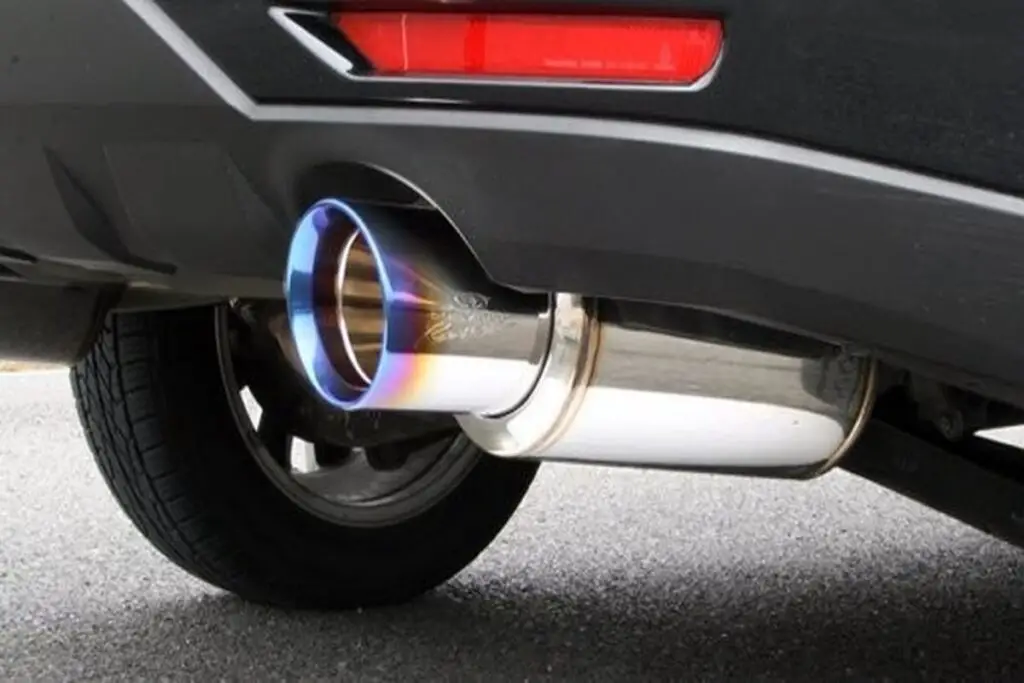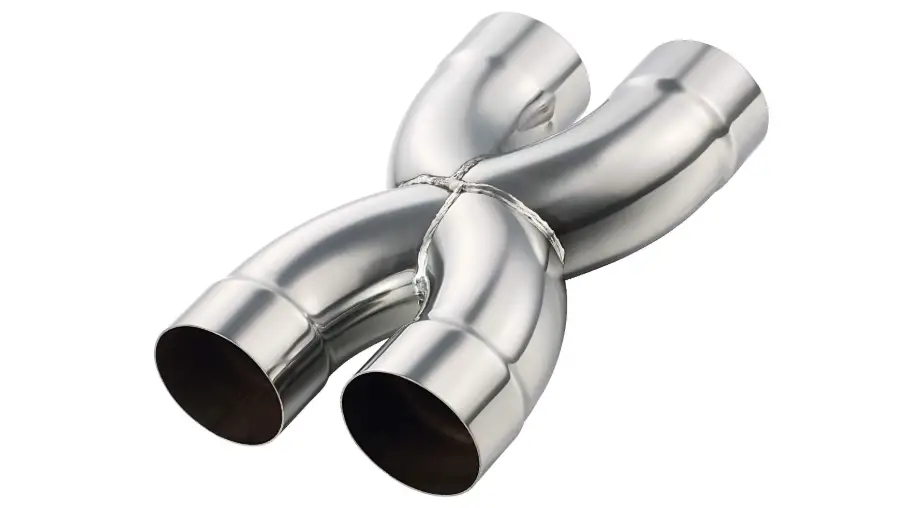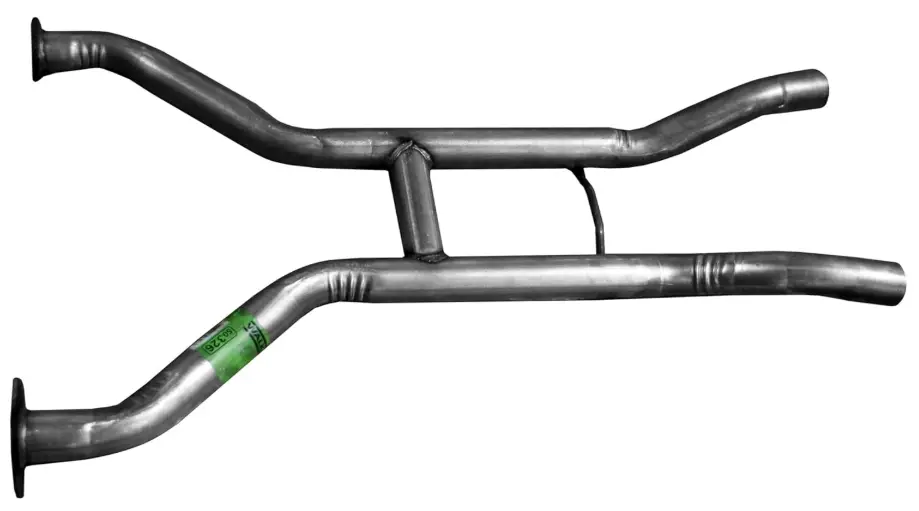X-pipes boost high-RPM power and give a smooth, raspy sound, ideal for sports cars. H-pipes enhance low-end torque with a deep, classic growl, perfect for muscle cars. Choose based on performance and sound preference.
When upgrading a car’s exhaust system, one common decision enthusiasts face is whether to install an X-pipe or an H-pipe. These mid-pipe configurations serve a critical role in shaping the sound, performance, and efficiency of the exhaust system. Each design has unique characteristics that suit different driving preferences and vehicle setups.
This blog explores the differences between X-pipes and H-pipes, their advantages and disadvantages, and how to choose the best option for your vehicle.

Contents
- 1 What is a Mid Pipe in an Exhaust System?
- 2 What is an X Pipe?
- 3 What is an H Pipe?
- 4 X Pipe vs H Pipe: Key Differences
- 5 Performance Comparison: Which is Better?
- 6 Pros of X-Pipes
- 7 Cons of X-Pipes
- 8 Pros of H-Pipes
- 9 Cons of H-Pipes
- 10 How to Choose Between an X-Pipe and H-Pipe
- 11 Frequently Asked Questions
- 12 Conclusion
What is a Mid Pipe in an Exhaust System?
The mid-pipe is a section of the exhaust system located between the headers and the mufflers. Its primary role is to direct exhaust gases from the engine cylinders into the exhaust system, ensuring smooth flow and optimal performance.
X-pipes and H-pipes are both types of mid-pipes, and they are often used in dual-exhaust systems to balance the flow of exhaust gases between the two sides of the engine. This balance improves performance, enhances sound, and can even help with fuel efficiency.
What is an X Pipe?
An X-pipe features a crossover design where the two exhaust pipes merge in the shape of an “X.” This setup creates a more streamlined flow of exhaust gases, as the crossover allows pulses from each side of the engine to merge and balance out. Read more about What Does An X Pipe Do For Exhaust?
Key Features of an X Pipe
An X-pipe is a component used in the exhaust systems of performance vehicles to optimize exhaust flow, improve sound, and enhance overall performance. Here are its key features:
- High-Flow Design: Promotes efficient exhaust scavenging, which enhances power.
- Sound Profile: Produces a high-pitched, smooth, and raspy exhaust note.
- Performance Focused: Ideal for higher RPM performance and vehicles designed for speed.
Common Uses: X-pipes are popular among performance enthusiasts and are often used in sports cars, race cars, and high-horsepower vehicles.

What is an H Pipe?
An H-pipe uses a different design, where the two exhaust pipes are connected by a horizontal pipe, forming an “H” shape. This setup provides a less direct crossover between the exhaust pipes, resulting in a distinctive performance and sound profile.
Key Features of an H-Pipe
An H-pipe is an essential exhaust system component used in many performance and muscle cars, offering distinct sound and performance benefits. Here are its key features:
- Balanced Design: Evens out pressure between the two exhaust streams.
- Sound Profile: Delivers a deeper, more traditional muscle car growl.
- Low-End Torque: Often improves low-end power rather than high RPM performance.
Common Uses: H-pipes are favored by classic car enthusiasts and those seeking a more traditional exhaust tone, particularly in V8-powered muscle cars.

X Pipe vs H Pipe: Key Differences
The X-pipe and H-pipe are two common crossover configurations in dual exhaust systems, each offering distinct benefits in performance and sound. Here’s a breakdown of the key differences between the two:
| Feature | X-Pipe | H-Pipe |
|---|---|---|
| Design | Crossover in the shape of an “X.” | Crossover in the shape of an “H.” |
| Exhaust Flow | Promotes faster, more efficient exhaust flow. | Provides balanced flow but less streamlined. |
| Sound | High-pitched, raspy, smooth tone. | Deeper, throaty, classic muscle car sound. |
| Performance | Optimized for high RPM horsepower. | Enhances low-end torque and responsiveness. |
| Best For | Sports cars, high-performance vehicles. | Classic cars, muscle cars, and low-end torque. |
Performance Comparison: Which is Better?
The choice between an X-pipe and an H-pipe depends on your vehicle type and performance goals.
Power and Torque
- X-Pipe: Maximizes exhaust scavenging, which increases horsepower, especially at higher RPMs. This is ideal for track racing or high-speed driving.
- H-Pipe: Improves low-end torque, making it better for city driving, towing, or vehicles that operate at lower RPMs.
Sound Characteristics
- X-Pipe: Produces a refined, smoother sound that is often described as exotic or race-inspired.
- H-Pipe: Offers a deeper, more aggressive rumble that suits muscle cars and trucks.
Efficiency and Fuel Economy
- X-pipes generally provide better fuel efficiency due to their ability to streamline exhaust flow and reduce backpressure.
Installation and Compatibility
Both X-pipes and H-pipes can be installed in a dual-exhaust system, but proper installation requires attention to:
- Vehicle Compatibility: Ensure the pipe fits your car’s exhaust setup and engine configuration.
- Customization Needs: Some vehicles may require custom fabrication to install an X-pipe or H-pipe.
- Emission Standards: Check local regulations, as modifications to the exhaust system can impact emissions compliance.
Pros of X-Pipes
An X-pipe is a popular crossover exhaust design for vehicles with dual exhaust systems. It offers several performance and sound advantages, particularly for high-performance applications. Here are the key pros of using an X-pipe:
- Enhanced High-End Power: Increases horsepower at higher RPMs.
- Smoother Exhaust Note: Creates a more refined, race-inspired sound.
- Improved Efficiency: Streamlines exhaust flow, reducing backpressure.
Cons of X-Pipes
While X-pipes offer numerous benefits in terms of performance and sound, they also have some drawbacks. Here are the potential downsides of using an X-pipe in the vehicle’s exhaust system:
- Less Low-End Torque: May not provide as much power at lower speeds.
- Sound Preference: The high-pitched tone may not appeal to all drivers.
Pros of H-Pipes
H-pipes are a popular crossover exhaust system design that offers distinct advantages, especially for vehicles aiming for balanced performance and a classic sound. Below are the key benefits of using an H-pipe:
- Increased Low-End Torque: Ideal for city driving and towing.
- Classic Sound: Delivers a deep, throaty growl.
- Easier Installation: Simpler design can make installation easier.
Cons of H-Pipes
While H-pipes have several benefits, they are not without their drawbacks. Below are some of the disadvantages of using an H-pipe in your vehicle’s exhaust system:
- Reduced High RPM Power: Less effective for top-end performance.
- Less Efficient Flow: The design doesn’t optimize scavenging as well as X-pipes.
How to Choose Between an X-Pipe and H-Pipe
Consider these factors when deciding:
- Driving Style: Choose an X-pipe for high-speed performance and an H-pipe for low-end power.
- Vehicle Type: X-pipes suit sports cars and high-revving engines, while H-pipes complement classic V8s and trucks.
- Sound Preference: Select the pipe that matches your desired exhaust tone.
- Budget and Installation: Factor in installation costs, as custom setups may increase expenses.
Related Article
Exhaust Pipe Paint
How to Bend Exhaust Pipe
Water in Exhaust Pipe
Frequently Asked Questions
Here are some FAQs about exhaust X pipe vs H pipe –
1. Does an X-pipe or H-pipe increase horsepower?
Both can increase horsepower, but an X-pipe provides better gains at higher RPMs due to its efficient exhaust scavenging. H-pipes excel in improving low-end torque.
2. Which pipe is louder, X-pipe or H-pipe?
An X-pipe generally produces a smoother, higher-pitched tone, while an H-pipe delivers a deeper and louder rumble, often perceived as more aggressive.
3. Can I install an X-pipe or H-pipe on any car?
Both pipes can be installed on dual-exhaust systems, but compatibility depends on your vehicle’s design and engine configuration. Custom fabrication may be required in some cases.
4. Does an X-pipe or H-pipe affect emissions?
Both can impact emissions depending on the setup. It’s important to ensure the system complies with local regulations, especially in areas with strict emission standards.
5. Which is better for fuel efficiency, X-pipe or H-pipe?
X-pipes typically offer better fuel efficiency because their streamlined design reduces backpressure, leading to a more efficient exhaust flow.
Conclusion
The choice between an X-pipe and an H-pipe ultimately depends on your vehicle, driving style, and preferences. If you prioritize high-end performance and a smooth, exotic sound, the X-pipe is the ideal choice. For those seeking low-end torque and a classic muscle car growl, the H-pipe is the better option. By understanding their differences and benefits, you can select the perfect mid-pipe to enhance your car’s performance and sound.
Pro Tip: Consult with an exhaust specialist to ensure proper installation and compatibility with your vehicle’s setup.